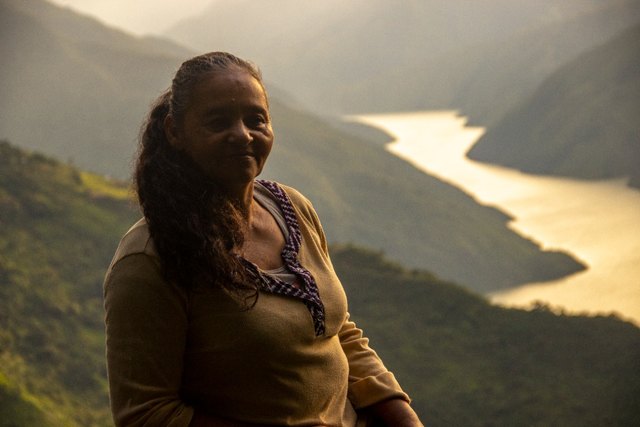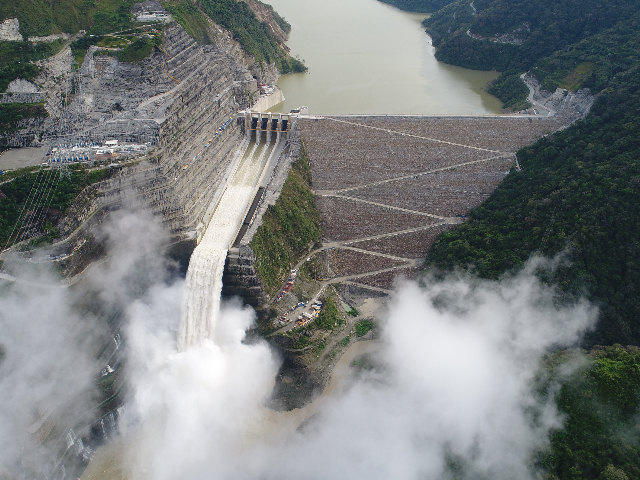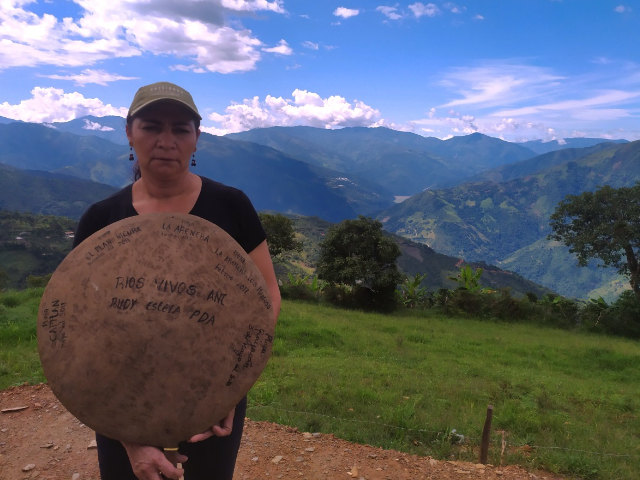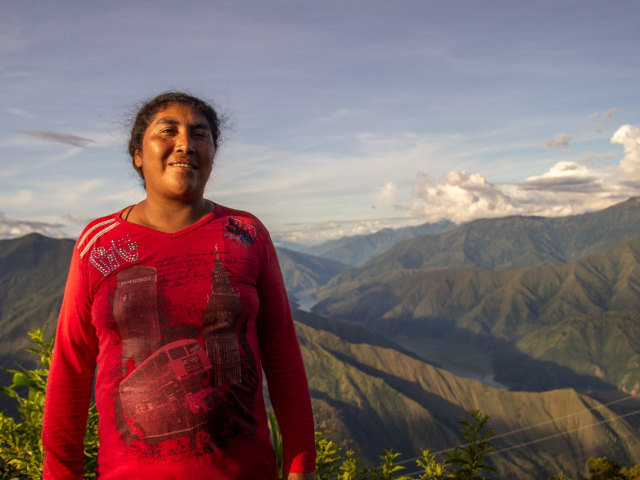
The Women who Name the Silence of Cauca
JUAN MANUEL FLÓREZ ARIAS
(COLOMBIA)
In 2018, the largest hydroelectric project in Colombia, Hidroituango, was on the verge of collapsing because the mountain caved in, and the Cauca River threatened to create an apocalyptic flood. This crisis is paralleled by another story: that of the women who lived on the banks of the Cauca and organized to oppose the project for a decade. They became witnesses of a river that no longer exists as they knew it.
Angélica Mazo holds onto the railing of the dam and observes the river as it flows into the spillway. The water drops 246 years, and when it hits the bottom, it produces a burst of spray that strips the mountain opposite of leaves, as if it were permanently on fire. “This is my river!” she tells me. Behind her—on the other side of the dam—the Cauca is a silent, green, motionless reservoir that does not resemble the river where she learned to fish and pan for gold at the age of nine. Conversely, on this side, movement restores the sound and brown color to the water, albeit in a slightly lighter shade.
Clinging to the railing, Angelica repeats the same gesture she used to make when she was a child, when she hung from the edge of the Pescadero Bridge, five miles north, which has now been submerged by the reservoir. “I would stay there for hours, looking at the river current and wondering where does it come from, where is it going, why doesn’t it end?”
She makes the same gesture but everything else changed. She is no longer a girl; she is 59 years old. This is not the bridge but the top of a dam, and the river, she says, is no longer the river; it is the engine of what was intended to be the largest power plant in Colombia.

Angélica Mazo, leader of the Setaa Communities in Briceño. Photo: Santiago Rodriguez
The Ituango hydroelectric project, in the west of Colombia, in the department of Antioquia, was supposed to begin operating three years ago, in 2018, and to produce 17 percent of the national energy demand. But that year, the tunnel used to divert the Cauca caved in, as a result of which the reservoir began to fill up before the dam had been completed.
The water threatened to overflow the wall where the reservoir had been built and breach it. The risk of an avalanche, which would have destroyed all the municipalities 256 kilometers downstream, forced the largest evacuation in the history of Colombia: 113,000 people were evacuated from five municipalities.
To prevent disaster, the water was diverted by the powerhouse, causing millions in losses. The wall had to be urgently completed in less than a month so that the excess water could be flushed out through a controlled channel, the spillway, rather than above the dam.
Three years later, water continues to fall there, while the project will begin to generate energy in 2022. And Angélica—who has spent the past 10 years trying to prevent the dam from being built—is mesmerized by it as she clings to the railing.
She is silent for a while until she changes her mind: this one does not look like her river. “Before it used not to sound like that. The sound of the water combined with the noise it made as it crashed against the rocks,” she says.
What Angélica misses about Cauca is not only its sound, interrupted by the stillness of the reservoir, but its complexity. She longs for the contradiction of the currents she stared at as a child, while asking the questions you ask yourself about something you love: Where does it come from? Where is it going? Why doesn’t it end?

Hidroituango. Photo: EPM
The Ituango hydroelectric plant was named after the first engineer who conceived of the dam: José Tejada Saénz. In 1969, in the document in which he proposed the project, he wrote about the Cauca River canyon: “God put it there so there would be a hydroelectric plant.”
Nearly four decades went by until, in 2007, the then governor of Antioquia, Luis Alfredo Ramos, re-examined the documents. He included the hydroelectric plant in his governance plan and in 2010, commissioned Empresas Públicas de Medellín (EPM) to undertake the project.
“What moved us was to fulfill a dream of Antioquia. We revisited the thesis of a great public company administrator, Diego Cayo, who said: ‘What Antioquia, with so many limitations placed on it by nature, can do is sell cloudbursts,’” recalls Ramos.
The history of this department, the second most populated one in Colombia after the capital, Bogotá, can be summarized as that of a region that attempted to dominate the world. It was the first site, in a country crossed by three mountain ranges forming part of the Andes, in which a mountain was perforated to create a tunnel, La Quiebra, in 1929.
Hidroituango was envisaged as another step in the quest to subdue the landscape. “The world has not seen another 70-kilometer-long canyon in the world, consisting entirely of rock, and so closed and uninhabited,” says Ramos.
The immensity of the river canyon makes it difficult to distinguish people. But even if you cannot see them, they are still there, between the mountains and the river banks.

Estela Posada, leader of Ríos Vivos in Toledo. Photo: Juan Manuel Flórez
Estela Posada—a 51-year-old fisherwoman and gold panner—holds a broad, round wooden vessel in front of her chest that she used to find gold in Cauca. Her name is written in the center and is surrounded by the dates and places of the five times she was evicted from the river while the dam was being built, between 2011 and 2018.
She repeated the process with each eviction. She left a mark on the pan and set up her house again slightly further upriver. She spent seven years trying to escape from the river. “They kept pushing me up the river until the water eventually forced me out,” she says
Estela is standing at the headquarters of Ríos Vivos, the organization to which she belongs, which led the opposition to Hidroituango. The house is in the municipality of Toledo, and they chose to build it on a mountain overlooking the dam.
Holding the pan, Estela recites the dates of the evictions. “June 2011, Capitán Beach. December 2011, Nicura Beach. March 2015, La Arenera. February 2017, Los Mangos. May 2018, Guayacán Beach.”
The dates surround her name like the hours on a clock. They record the times of the progress of the dam, but also the acts of resistance to it.
It was the women who led the rejection of the dam. Gold panning, the process of finding gold in the river, was mainly undertaken by women. The river was a common space on whose banks they lived, planting seeds, giving birth, and burying the bodies that floated down on it.
That is why —Estela says—they tried to prevent it from being flooded. She was the one who, in 2013, led a caravan of 350 people from Pescadero bridge to the capital, Medellín, 103 miles away. It began as a protest over the arrest of 12 members of Ríos Vivos at another demonstration. They walked eight hours to the municipality of San Andrés de Cuerquia, where they spent the night.
“No pude dormir nada. Solamente podía pensar en qué me había metido, cómo iba a responder por toda esa gente”, recuerda Estela.
She still had not managed to find an answer by the morning when, on the mountain opposite, she saw several EPM buses coming down the road from the construction site. She organized about twenty of her companions to cut them off. Eight buses were seized and rerouted. The detainees were released, but decided to continue the caravan to Medellín, the capital.
On March 19, 2013, 350 farmers and gold panners affected by the hydroelectric plant entered the city on buses owned by the company responsible for building it. They did it by honking the horns. “We selected a colleague on each bus to sound the horn. When we arrived, we got off, and said to the drivers: ‘Thank you very much, see you later.’ Some of them were furious,” recalls Estela, laughing.
They spent seven months in the coliseum of the University of Antioquia, demanding to negotiate with the then governor, Sergio Fajardo. Also in the group was Angélica, who had left her home in Briceño to live in a makeshift tent for over half a year.
But in October, tired and with no clear agreement, they returned to their municipalities. A couple of months later, on February 17, the project became irreversible. The EPM diverted the Cauca River through two tunnels carved through the mountain, to dry up the sector where the dam was to be built.
“They had been planning this moment for years, but we never believed that engineering could make this a reality. The Cauca seemed indomitable,” declared one of the reporters who broke the news.
Estela was in the Valley of Toledo, a nearby township, and saw a priest on television who blessed the dam before the detonation that shifted the river out of its channel: “I never believed in priests again. That day I lost my faith.”

Hidroituango Reservoir. Photo: Santiago Rodriguez
When Bernardo Torres used to dive into the river, before the dam was filled, he used to feel a force trying to drag him away. It was as if the water wanted to carry you somewhere else, further down,” he says.
His wife, Acened Higuita —a gold panner and president of communal action in Nueva LLanada village in Peque, 15 miles upriver from the dam—believes that this force was what caused the crisis in 2018.
“If you dam a river, you have to deal with the consequences. It is like building a house next to the gorge. You invade her territory, and at some point, she is going to want to reclaim it,” she says.
All rivers lead to the sea. The Cauca drops 1,350 kilometers from its source in the Colombian massif to join the Magdalena River, the largest in the country, and together they flow into the Caribbean Sea 299 kilometers further down.
The Hidroituango wall is the biggest interruption to this route. The pressure that almost breached it in 2018 was partly the watercourse trying to re-assert itself.
The first sign of danger Estela detected from the river was its silence. She liked having her house near the shore, so she could be lulled asleep by the sound of the water. In the early morning of May 8, 2018, she woke up on Guayacán beach, where she had been living with her son for a year, earning a livelihood from fishing and gold. She noticed she could not hear the river.
When she got out of bed, the water came up to her knees. She removed what she could, with the help of her son, and they climbed up the ravine. There they noticed that it was not a normal flood; the waters were not subsiding.
Several kilometers further ahead, in the dam, the Cauca diversion tunnel had collapsed because the mountain had caved in. The water that flowed down from the massif—2,500 cubic meters, equivalent to an Olympic swimming pool, every second—began to fill the Cauca River with Estela and other gold panners inside it.
Estela and her son could not tell whether the water was rising just by looking at it. “We started putting little sticks on the shore, as markers. After 10 minutes, the water made them float,” she recalls.
Even a movement as violent as the filling of the canyon containing the Cauca could not be seen with the naked eye because of the immensity of the mountain. It could only be confirmed by leaving a sign to record the passage of time.
Gold panners like Estela know all about signs. Their job is to interpret the marks on the banks to find the gold underneath. Above all, gold panning involves being aware of the riverbed.
And that is precisely what gets lost with dams: the riverbed. The latter is buried by the water that fills the reservoir or trapped in the wall of the dam, which retains sediment and enables the river to continue flowing without what it once contained.
“Sediment contains nutrients, the food for life that depends on the river. It carries the life of the river. If you remove it, you destroy the dynamics of the river,” says Jorge Alberto Escobar, an expert in fluid mechanics and the person responsible for the study on the impact of the dam on the waters of the Cauca undertaken at the Javeriana University.
In addition to the sediment, in Hidroituango, the places the gold panners had named had also been submerged: the stone of the drowned woman, Pescadero bridge, the peephole. “We baptized everything there. The paths, the stones, the bends in the river,” says Estela.
Estela and her son managed to avoid the river for five days until it pushed them up against the mountain. There they were rescued by the EPM boats, but before they boarded them, they stored the things they had salvaged in the mountains so they could go back for them once the waters had subsided. A few hours later, they were also submerged, together with all the names.

Acened Higuita, leader of the Setaa Communities in Briceño. Photo: Santiago Rodriguez
Thirty years ago, when Acened Higuita was 15, her neighborhood slid down the side of the mountain one morning. She and her neighbors fled, but Llanada neighborhood in Peque remains uninhabited.
Acened says it was not a natural disaster. “It was the result of erosion because we had cut down a lot of trees. There came a day came when the mountain got tired and said: if you don’t take care of me, I won’t take care of you either,” she explains.
They rebuilt the neighborhood on the other side of the mountain and called it Nueva Llanada, “so that it would not completely disappear.” Acened now lives there, upriver from the dam, at the highest point before the descent to the river begins.
At that height, the landscape resembles a map. You can name the surrounding municipalities just by pointing at them: Sabanalarga, Toledo, Briceño and Ituango.
It was here that Acened watched the Cauca become a dam in May 2018. The water, which could barely be seen among the bends in the canyon, began to rise. Then it stayed still, stopped flowing, and turned from brown to green.
Bernardo, Acened’s husband, with whom she had spent several stints living on the riverbank, says that on the few occasions when she returned to the river, she did not recognize the fish. “Before, you could catch bocachico, bream, catfish and beardfish. Now there are some whose names you do not even know.”
“Life in the water depends on how that water moves,” says Jorge Escobar. In a reservoir, once the flow of the river has stopped, the fish are different from those in a normal river.
The fauna monitoring carried out by the University of Antioquia, in conjunction with EPM, identified 42 species in the reservoir and 108 below the dam. Of these, only a few species coincided above and below the wall. Others, such as the bocachico and gilt-head bream, which rose from the mouth of the Magdalena, swimming against the current of the Cauca, are being caught in the dam.
Unlike Bernardo, Acened has not been back to the river since it flooded. “In the early days, a lot of people went out of curiosity. I didn’t. It would make me feel nostalgic not to find any of the places where we lived,” she says
During the time they spent in Cauca, they used to dismantle their wooden and plastic farms and rebuild them on another shore where there was gold: “We gold panners carry our houses on our backs,” she explains. It may look as though you’re rootless, but in fact, it is quite the opposite. It means you always carry your home on your back.”
Acened taught all her daughters to pan for gold, except for three-year-old Mariángel, a granddaughter she raised in her home, who was born when Cauca was already a dam.
“She did not see the river when it was alive,” she explains. Imagine what will happen when Hidroituango’s useful life ends, in about 50 years. “I won’t be here then, but she will.” She looks at her intently for a moment and adds, “She’s going to have to experience things she didn’t even choose.”

Photo: Santiago Rodríguez
The last time Angélica Mazo went down to the river, before the flood, she did not find a single gram of gold. She spent her time collecting seeds, stones, and snails from the shore, “those little houses abandoned next to the water.”
Then she took them up the mountain to her house in the district of El Orejón in Briceño. Along the way, she felt the weight and hesitated. “Why am I carrying all this?” But she decided to take it to the top.
Angélica set up an altar with the objects she had retrieved from the river, placing them on a shelf in the main hall. In the center she put two seeds in the shape of a heart.
“I found them among the snails. I have never planted them. What if I bury them and they grow, and I lose my heart?”
Apart from the items on the shelf, there are not many other signs of what has been submerged in the dam. In that respect, the reservoir looks like the past. It is an inventory we cannot access, of which there is not always evidence, yet which we know exists, under the surface.
After saying goodbye to Acened, I make my way down to Cauca on a three-hour mule ride from her home. Junior, who lives nearby and acts as a guide, goes on ahead. The further we descend, the less clear the trail is, and it begins to be confused with the undergrowth. Only three years have passed since the flood, but the path to the river has practically been abandoned.
Junior has to clear the trail again with a machete. On the right, on the other side of the reservoir, you can see the parts of the mountain that have crumbled because of erosion. The dammed water, which conceals what is at the bottom, also exposes the earth, weakening it underneath and causing it to collapse.
Below, on the bank, the water is static, and makes no sound. After it was filled in, the Cauca became like a navigable lake, across which fishermen informally ferry civilians and sometimes armed groups that force them to take them: dissidents from the former guerrilla of the Revolutionary Armed Forces of Colombia (FARC)—who took up arms— and members of the Gulf Clan, a residual paramilitary group, who are fighting for control of the area.
We continue down to the riverbank for another ten minutes. There, hidden behind the undergrowth, are two EPM posters. The first, in the voice of the company, says: “Private property: water unsuitable for aquatic activities and fishing.” The second, in the voice of the river, says: “Be careful. I am the Cauca River, and my water could affect your health.”
This report was originally published in La Silla Vacía on September 18, 2021, as part of the “Women Defending their territory” project by Climate Tracker and FES Transformación.











Leave a Reply